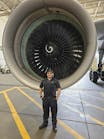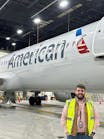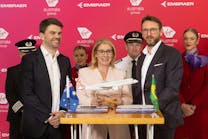What It was Like Flying on American Airlines' Last MD-80 to Depart DFW
Capt. Bruce Taylor welcomed about 40 guests aboard the last passenger flight of an American Airlines’ MD-80 aircraft at DFW Airport.
As the door shut and the passengers settled into their seats, Taylor, who has flown variations of the MD-80 for 25 years, was feeling nostalgic. He had mixed feelings about flying his favorite type of plane on its final voyage — destined for long-term storage at an aircraft boneyard in Roswell, N.M.
“For the prestige of the airplane, I’m actually going to hand-fly this plane. No need for autopilot,” Taylor told the passengers on the plane’s public address system. “It’s just a little bit of recognition for this airplane, and how it came into the jet age and really expanded our airline into what it is today.”
And with that, the vintage brushed-silver plane taxied to the runway and took off like a missile into the North Texas skies, for a noisy one-hour and one-minute flight to Roswell, N.M., where the plane bearing tail number N9615W would be parked indefinitely and perhaps eventually scrapped for parts or sold to a smaller airline.
“It was a great airplane of the time,” American Airlines chief executive officer Doug Parker said, before boarding another retiring MD-80 with fellow company employees at DFW Airport’s Terminal C. “It was replacing the older 727s, and it was at that time state of the art.”
But, Parker agreed, “It’s time for it to go. We have nicer, more comfortable and more efficient airplanes for our customers, but it has served us well.”
The MD-80 aircraft was once the workhorse of the American Airlines fleet.
The skinny commercial jets were beloved by frequent flyers for their lack of a middle seat in half the cabin (with two rows of seats one side, and three on the other), and by pilots who cut their teeth on the pair of obnoxiously loud Pratt & Whitney engines mounted by the tail.
And, for decades, until about 2005, they were the most common airplane spotted in the skies over DFW Airport. In 2004-05, Fort Worth-based American Airlines was running 362 MD-80s, nearly half its entire fleet.
But the MD-80s, which unlike the rest of American’s fleet still sports the old, brushed-metal paint job, are also a relic of a bygone era.
The medium-body aircraft, which held 130 to 175 people depending upon the configuration, has since been replaced by modern, more fuel-efficient planes.
For example, a Boeing 737-800 can carry about 20 percent more passengers than an MD-80, all while using 20 percent less fuel, according to the travel industry blog The Points Guy.
“At 147 feet from nose to tail, it’s one long and skinny bird, made to look even sleeker by thin, small wings and engines placed at the tail,” Alberto Riva wrote in The Points Guy.
He noted that, while the engines on the MD-80 — sometimes called the “Mad Dog” — made an awful noise for those unlucky enough to be sitting in the rear of the plane, they could hardly be heard by passengers sitting in the front of the narrow fuselage.
“Those engines are, in fact, the reason that the Mad Dog is so beloved of aviation fans everywhere,” he wrote. “With their 1970s technology, they’re a sonic reminder of the days when even tame commercial transports howled like fighter jets.”
On Wednesday, as guests boarded the last MD-80 passenger flight out of DFW, many remarked about the ample legroom — also a bygone era of commercial aviation — as they found their seats. A few laughed that the MD-80s seats featured cigarette lighter power ports.
Near the end of the flight, as the aircraft descended into eastern New Mexico, passengers peeked out their windows at the many other abandoned aircraft parked at the former Roswell Army Air Field.
There were jumbo jets, regional propeller planes and even Elvis’ famous red 1962 Lockheed JetStar. The latter has been parked in Roswell for decades, although recently there have been reports it would soon be auctioned off.
Guests filed into a maintenance hangar to listen to several current and retired pilots tell their stories about the MD-80.
Taylor, the captain of the last flight, said he taught in an MD-80 simulator for 10 years and also worked as a test pilot. He said the MD-80 had “a remarkable safety record.”
“When Douglas Corp. originally built the DC-9, they made it very simplistic. It’s all control cables,” he said in an interview. “It didn’t even have flight guidance until later on, when they merged into McDonnell Douglas and it came out as the MD-80 and they added flight guidance to it. But it was still at its core a basic airplane on a manual system.”
Finally, the captain added, “Now it’s kind of sad that I’m actually doing the delivery to its retirement out to the desert.”
———
©2019 the Fort Worth Star-Telegram
Visit the Fort Worth Star-Telegram at www.star-telegram.com
Distributed by Tribune Content Agency, LLC.


